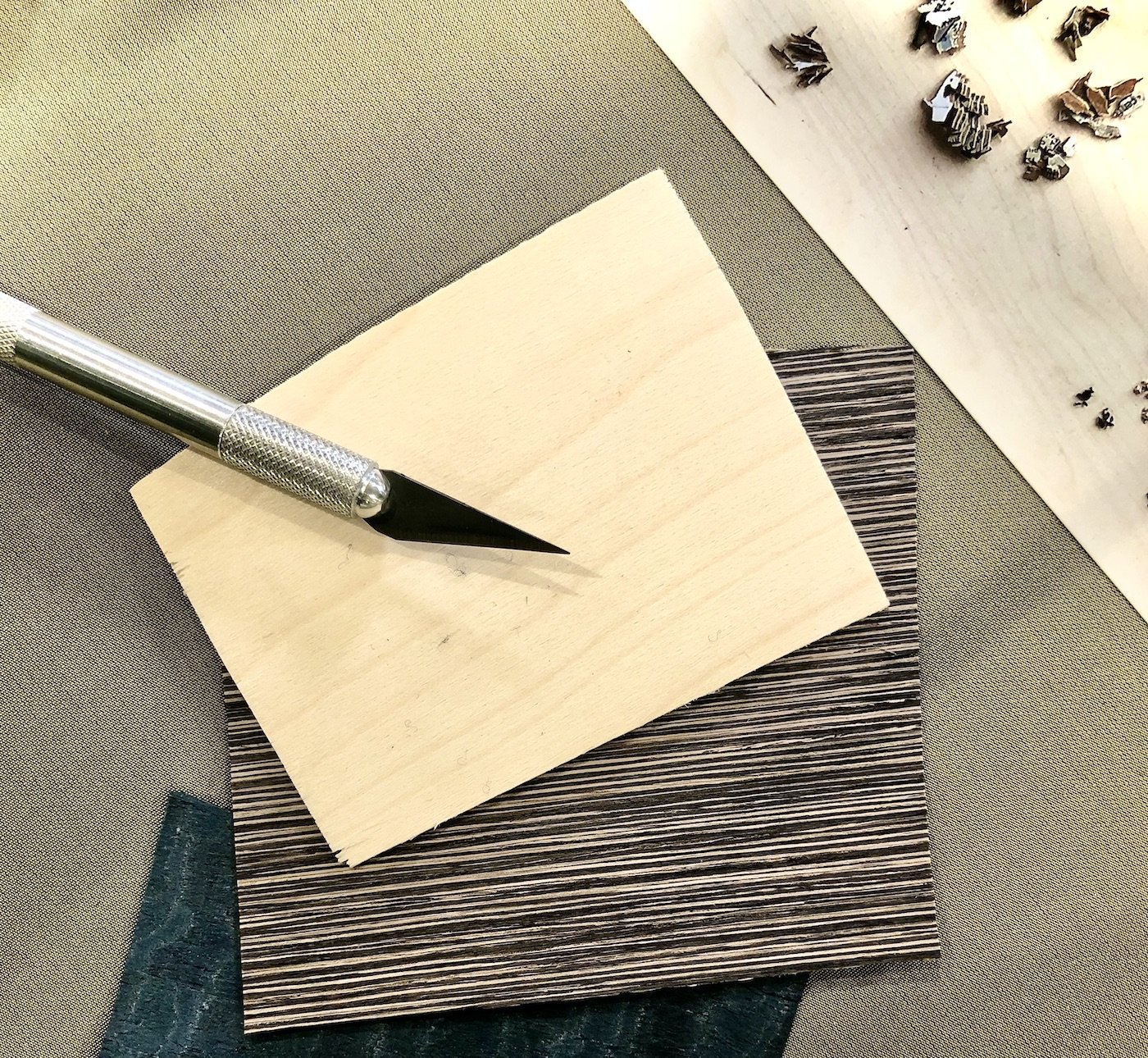mployed today by the venerable house of Patek Philippe, Jérôme Boutteçon chooses to keep what is an astonishing human adventure to himself. We have met him twice: the first time in 2017 at the Cipriani luxury hotel in New York, where the Patek Philippe Art of Watches Grand Exhibition was being held, and last April, at 41 rue du Rhône, the address of their Geneva boutique.
A vivacious 60 year-old with a sparkle in his eye, Jérôme Boutteçon exudes the serenity and assurance of a master craftsman at the pinnacle of his art. He develops his works in a typical Franche-Comté dwelling sculpted by his own hands, far from the city and its clamour, seeking neither medals nor camera flashes. For him, celebrity is a foreign word. Yet he played a defining role in the invention of a whole new decorative art: wood marquetry on watch dials.
-

- Patek Philippe “Oryx” pocket watch, ref. 995/118J-001. A one-off piece from the Rare Handcrafts 2022 collection.
- Hubert de Haro / HDH Publishing
Marquetry or parquetry?
More than three millennia ago, the artisans of Upper Egypt were already using the technique of marquetry. Much later, the Italian Renaissance, in the person of Vanni dell’Ammannato of the Siena School in Tuscany, developed a version of the craft in line with contemporary taste, then called intarsia, from the Arab word, tarsī.
In actual fact, this word encompasses two very distinct techniques, which the Grove Encyclopedia describes thus: “Marquetry: Pattern or design assembled from small, shaped pieces of veneer. With marquetry the entire surface, including the background, is veneered, whereas with inlay, with which marquetry is historically associated, the pattern pieces are laid into a solid ground.”
-

- Tiny pieces of multiple species of wood, hand-sawn then sorted and grouped together prior to assembly of the complete motif on the dial of the Patek Philippe Oryx pocket watch, ref. 995/118J-001.
- Hubert de Haro / HDH Publishing
The 17th century saw marquetry attain an unparalleled degree of perfection as a result of two crucial events. In Germany, metallurgists developed new saws capable of cutting extremely fine shapes. At the same period, the East India Company imported from Asia exotic, until then completely unknown species of wood.
Gradually, this intricate art spread throughout Europe, finally reaching France through the cabinetmaker Jean Macé (1602-1672), who trained in Middelburg in Zeeland, part of what is now the Netherlands. At the request of Anne of Austria, he created an intricate parquet floor with fascinating geometrical figures for the Palais-Royal. It won unanimous praise, so much so that this new technique came to be called “parquetry”, a term still used today for wood marquetry laid in such a way as to form geometrical patterns.
The Boulle method
The cabinetmaker Jean Macé lived and worked in the galleries of the Louvre, a privilege granted by King Louis XIV to a handful of artisans who were recognised for their exceptional skills. They also represented an experienced and innovative workforce permanently at the service of the king and his architects.
Following the death of Jean Macé in 1672, his lodgings in the Louvre passed to a rising star of French craftsmanship: André-Charles Boulle (1642-1732). Rapidly promoted to the rank of first cabinetmaker to the king, his patent – and consequently the professional skills he was authorised to practise – far exceeded woodworking alone, as the art critic Pierre Kjellberg attests: they covered those of “architect, painter, sculptor of mosaic, chaser-engraver, marquetery, inventor of monograms”.
-

- Patek Philippe pocket watch, ref. 995/118J-001. A one-off piece from the Rare Handcrafts 2022 collection. 223 pieces in total, 23 different species of wood.
Boulle’s rare longevity, nurtured by a never-ending creative frenzy, was to make him one of the most sought-after artists of European royal courts and collectors. His influence was such that even today, art historians use the term Boulle to refer to a type of marquetry that uses combinations of wood, metal (copper, brass, pewter or bronze) and tortoiseshell.
But, as Pierre Kjellberg explains, his “most original” innovation by far “consisted in cutting, sandwiched together, a plate of copper and a light-coloured sheet of tortoiseshell, depending on the chosen design, thus creating two panels both similar and different at the same time. In the first, called the première partie, or “primary part”, the decoration would be copper on a tortoiseshell ground, while in the second, called the contrepartie, or “counterpart”, the decoration would be tortoiseshell on a copper ground”.
The Boulle method – superposing sheets of material when cutting – came into general use. It offers the great advantage of allowing the best part of the material to be selected from several absolutely identical parts.
Learning the landscape of wood
Today, some wood marquetry professionals restore these antique pieces of furniture either made or inspired by Boulle. Others produce boxes and caskets with subtly ornamented lids. Some even specialise in landscape scenes – a practice in which the Spindler family have excelled for three generations.
Based in the former Benedictine abbey of Saint-Léonard in Alsace, over the years these artisans have perfected the art of reproducing emblematic landscapes of the region in wood. A loyal customer base buys these works of astonishing depth and expression, the dimensions of which sometimes run to several metres.
-

- Preparatory sketch signed “jb. nov. 2015”, with a list of the wood species chosen for this jigsaw puzzle of 315 tiny pieces of veneer.
- Hubert de Haro | HDH Publishing
In the 1980s, the reputation of Spindler reached neighbouring Franche-Comté, where the young Jérôme Boutteçon was completing his training as a cabinetmaker. He travelled to Alsace to apply for a job there. He was accepted and took up his post in the unusual premises of the family company. Where a novice would see nothing but an inert plank of wood, he learned from his apprentice-masters at Spindler how to distinguish the minutest nuance in colour, texture and vein.
Like a painter, he drew up his own palette, not of pigments but of an infinite number of fine slices of wood. Through endless repetition of the same gestures, he developed a unique feeling for marquetry and discovered the incredible precision of these manual, pedal-driven saws.
Sainte-Croix, a crucible of possibilities
In the early 1990s, Jérôme Boutteçon decided to change companies, country and format of marquetry. He got a job with Philippe Monti, a company specialising in the production of wooden caskets based in Sainte-Croix high up in the Swiss Jura, and the global epicentre of a dense network of companies devoted to art mechanisms.
Thanks to his dexterity and sensitivity, he created bold, miniature marquetry designs, delighting Davidoff, the company’s main client… and himself when, in 1994, he won the coveted title of Meilleur Ouvrier de France – the best craftworker in France. Orders flooded in and new apprentices were needed: this was when the young cabinetmaker Bastien Chevalier joined the team.
-

- Atmos du Millénaire clock with “Aurora” marquetry, by Jaeger-LeCoultre. A limited series of 25 cabinets inspired by works of the artist Alphonse Mucha, made in 1999 and signed “cabinetmakers J. Boutteçon and Ph. Monti”.
Eventually, the quality of Philippe Monti products came to the attention of watchmakers. The Sainte-Croix-based company produced 25 marquetry cabinets for a special series of the Atmos Millénaire clock, inspired by Alphonse Mucha’s Four Seasons, for the Jaeger-LeCoulture manufacture. In 2000, in a rare interview granted to the Journal des Arts, the craftsman stated: “Marquetry? At first, it’s an artisanal craft. If you put your soul into it, it becomes an artisanal art.” The same year, he won the Concours National des Métiers d’Art arts and crafts competition.
Arrival at Patek Philippe
The result was of such finesse that the Geneva-based company, Patek Philippe, contacted Philippe Monti. So it was that Philippe Stern, an aesthete and art lover and, at the time, proprietor and head of Patek Philippe, made the acquaintance of the master craftsman, Jérôme Boutteçon. That meeting was to mark a turning point for the latter. It came at a time when the Philippe Monti company was experiencing internal management difficulties which in 2004 resulted in a takeover by a competitor in La Chaux-de-Fonds: Opal Créations SA.
The master craftsman joined the new structure and for a decade developed a number of wood marquetry projects. It is difficult to state with any certainty who first breathed the idea to Jérôme Boutteçon of attempting the demanding Boulle technique on a watch dial. But according to him, he is certain that the first attempts were conducted for Blancpain. Other projects followed, such as the bear-motif dial for the Cartier Rotonde Jumping Hours watch.
-

- Patek Philippe “Leopard” pocket watch, ref. 995/137J-001. A one-off piece from the Rare Handcrafts 2023 collection. Dial in gold, with marquetry in black-stained tulipwood and 21 other species, 363 pieces in total
In a video dating from 2012, Jérôme Boutteçon explains his work in minute detail, from the choice of woods through to the intricate stage of cutting. “The quintessence of this profession is to rigorously apply the values of the craft, to seek the precise gesture,” he said back then.
Today, Jérôme Boutteçon is employed by Patek Philippe. From project to exclusive series, his art has become more sophisticated. He multiplies the species of wood to create perfect, ever more complex designs, as he poetically put it to the magazine Le Point in 2018: “In certain woods, you discover motifs that only the greatest painters would be capable of rendering, for example, a chestnut tree as a sunset.” He has refined the monumental tool at which he works: a manual, pedal-driven saw he designed himself, reminiscent of a traditional weaving loom and the first tools he used at Spindler.
A new take on a preserved legacy
“He taught me everything,” Bastien Chevalier recently confided to us. This independent wood marquetry artist perpetuates the teaching of his master, Jérôme Boutteçon, with whom he still maintains a close friendship based on six years together at Philippe Monti. The former apprentice has blossomed into an outstanding practician of this miniaturist art, a go-to professional and one of the rare recipients of the teaching at Philip Monti, as he explains: “I still use the same technique that Jérôme Boutteçon taught me.”
-

- Patek Philippe “Portrait of a Samurai” pocket watch, ref. 995/131G-001. Dial in gold with a marquetry design made from 800 tesserae from 53 different species of wood. A one-off piece from the Tokyo Rare Handcrafts 2023 collection.
In turn, with the kindness so typical of him, he encourages Rose Saneuil, who trained in marquetry and cabinetmaking at the École Boulle in Paris and whom he met at a trade show. She opened her workshop in 2013 and chose the path of miniature marquetry. Here is how this marquetry specialist, appreciated for her inventiveness, defines her work: “I make multi-material marquetry, I don’t really like to use the term ‘marquetry artist’ . But marquetry is a pretext: what interests me first and foremost is to bring materials together. For example, I work with numerous species of wood (sycamore, European lacewood, amaranth, walnut burl, and so on), but also gold leaf, bone, straw, mother-of-pearl, leather, zinc, shagreen, parchment, as well as brass, beetle elytra, eggshell, slate, feather, dried-flower petals and even quartz.”
So, master craftsman Jérôme Boutteçon has bequeathed a universal heritage to his closest apprentices and others who, perhaps even without knowing his name, are trying their hand at this wonderful new decorative art of his invention: wood marquetry on dials.














































